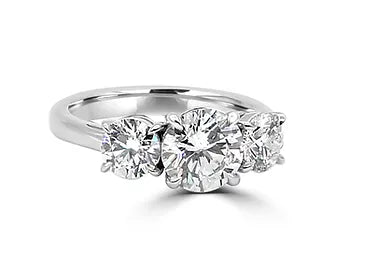What is Fluorescence in a Diamond
Fluorescence is a type of luminescence that can occur in gas, liquid, or solid chemical systems. It’s an emission of electromagnetic radiation, usually in the form of visible light, and caused by the absorption of energy from incident radiation or particles, such as electrons. A common example would be your everyday fluorescent light bulbs. Electricity causes the gas inside of the bulb to emit ultraviolet (UV) radiation, which then stimulates a powder coating inside to give off visible light.
Diamonds are purely carbon-based, although in some cases they can contain impurities such as aluminum, boron, or nitrogen. When present in the diamond’s atomic structure, the energy from UV sources can be absorbed by their electrons. A lot like light bulbs, diamonds release the energy as visible light, which is what we observe as fluorescence. Once you remove the UV source, the diamond stops fluorescing.
Overall, fluorescence is pretty rare in comparison to the diamonds that don’t have it. According to the GIA, only about 30% of all diamonds show some level of fluorescence. Diamonds that fluoresce usually glow blue, although in rare cases, they can glow yellow, or white. The GIA describes a diamond’s fluorescence by its intensity: None, Faint, Medium, Strong, and Very Strong. If Medium or higher, the fluorescence color is also noted.
What are the positive and negative
Although the trace impurities in the structure of a fluorescing diamond replace the carbon atoms, it isn’t necessarily a bad thing. It’s entirely a natural part of the diamond. The microscopic shifts in the diamond structure don’t weaken the diamond or make it less durable.
Positive
Most diamonds with faint fluorescence have no significant impact on their color or appearance. However, diamonds with a low color grading (think J-PQ) that have medium to strong blue fluorescence can actually look more white when exposed to UV light. When it comes to diamonds, the impurities within their chemical composition is also what affects their base color - in the case of yellow diamonds, nitrogen is incorporated into the carbon crystal structure and absorbs the blue part of the visible spectrum.
The result is that when a diamond has Blue fluorescence, the two colors cancel each other out, making yellow diamonds appear whiter or colorless when compared to diamonds without any fluorescence. At best, a diamond can appear even Two color grades higher than it actually is.
Negative
On the other hand, colorless diamonds (D-H range) with medium or strong fluorescence are depreciated in their value as a result. These diamonds can also have an oily or hazy appearance as a result of the fluorescence, even in normal lighting but not always, and it also depends on the diamond composition. Light doesn’t pass through the diamond as well, taking away from its appearance.
In Conclusion
According to the GIA Fluorescence Study, the fluorescence of a diamond doesn’t affect its appearance. However, you personally may find that it does affect the appearance, and potentially for the better. When shopping for a diamond, it’s best to look at it under different lighting conditions, compare it to other, non-fluorescent diamonds, and ask your jeweler any questions about its fluorescence before making a final decision.





